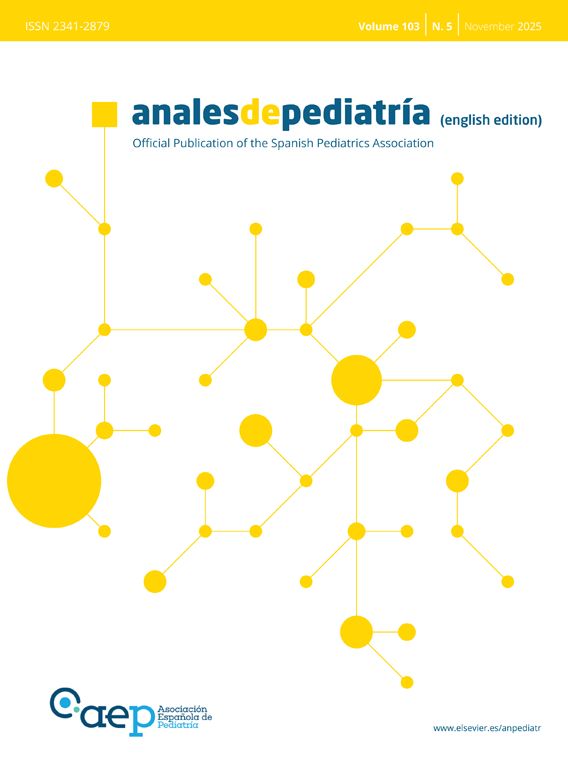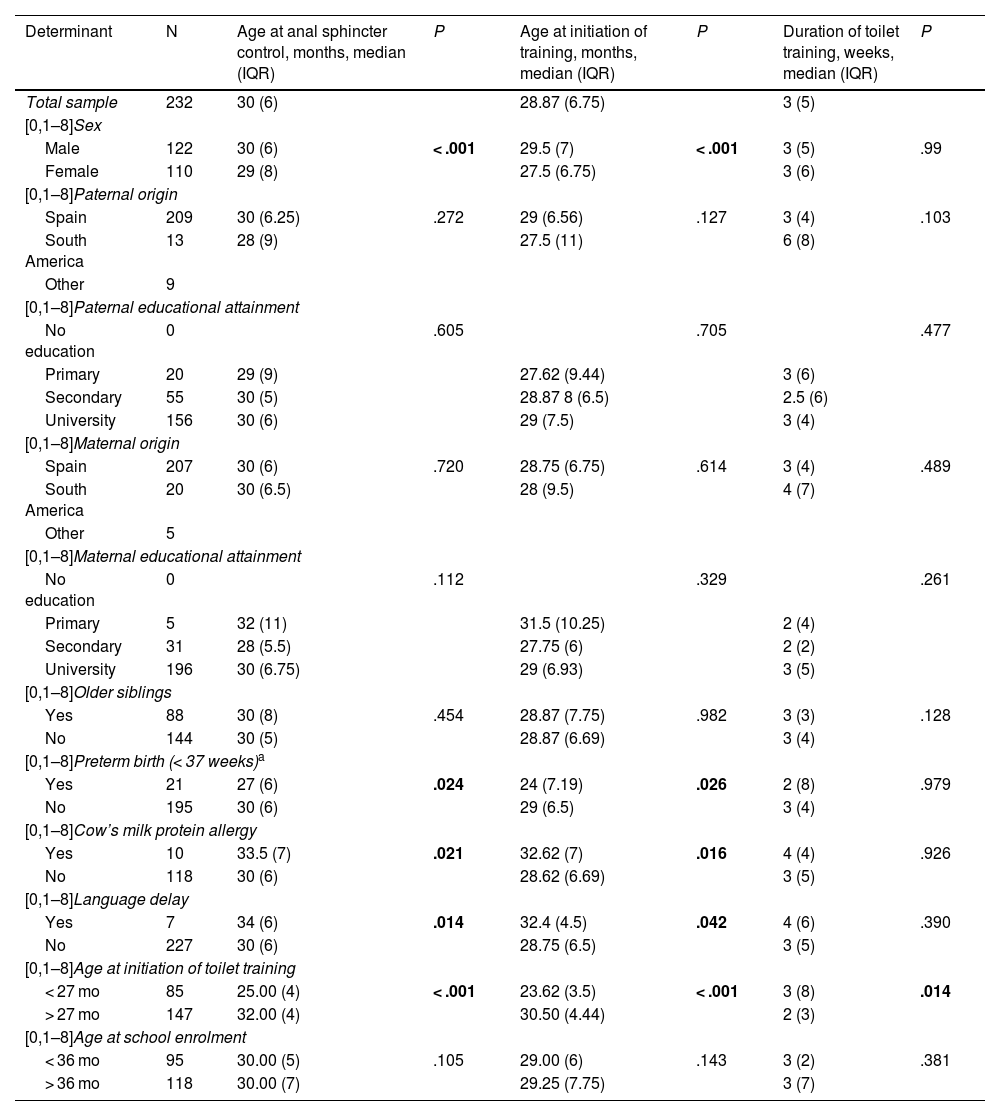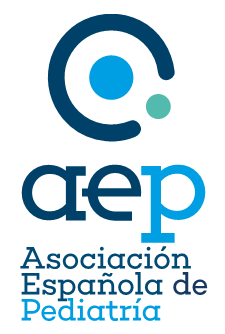Toilet training often poses a challenge to parents and caregivers. Although this is a frequent reason for consultation, there is a certain lack of evidence on the subject.1
Early initiation of toilet training (before age 27 months) is associated with longer duration of training,2 but the existing evidence on its impact on future constipation is contradictory.3,4 In Western countries, there has been a trend toward later completion of toilet training,5 particularly in boys, children of working parents and children with developmental delay.6
With the aim of describing the factors associated with the time of initiation of toilet training and the time to achievement of anal sphincter (bowel) control, as well as their association with the prevalence of constipation after toilet training, we carried out a multicenter cross-sectional retrospective study in 2 Spanish hospitals over a 6-mo period. We distributed a 25-item questionnaire to parents of children aged less than 5 years who were in any of the waiting areas of two secondary care hospitals, whose child had completed toilet training (defined as the period spanning from the first time the diaper was not used to the time the diaper was no longer used for bowel movements) in the past 24 mo, in order to collect data on demographic and clinical variables. The statistical analysis was performed with the software SPSS version 25.
Of the total of 239 received responses, 232 were included in the analysis (7 were excluded because they were incomplete), of which 122 referred to boys (52.6%) and 110 to girls (47.4%). The median age at initiation of toilet training was 28.87 mo (IQR, 6.67) with a median age at achievement of bowel control of 3 mo (IQR, 6). The median duration of toilet training was 3 weeks (IQR, 5).
Table 1 summarizes the findings concerning the factors associated with the age at achievement of bowel control and the duration of toilet training. In the univariate analysis, male sex, language delay and a history of past or current cow’s milk protein allergy (CMPA) were significantly associated with delayed initiation of toilet training and of achievement of bowel control, but not with the total duration of toilet training. On the other hand, preterm birth was significantly associated with earlier initiation of toilet training and achievement of bowel control, but also not associated with toilet training duration.
Determinants of age at initiation of toilet training and at achievement of anal sphincter control and duration of training.
| Determinant | N | Age at anal sphincter control, months, median (IQR) | P | Age at initiation of training, months, median (IQR) | P | Duration of toilet training, weeks, median (IQR) | P |
|---|---|---|---|---|---|---|---|
| Total sample | 232 | 30 (6) | 28.87 (6.75) | 3 (5) | |||
| [0,1–8]Sex | |||||||
| Male | 122 | 30 (6) | < .001 | 29.5 (7) | < .001 | 3 (5) | .99 |
| Female | 110 | 29 (8) | 27.5 (6.75) | 3 (6) | |||
| [0,1–8]Paternal origin | |||||||
| Spain | 209 | 30 (6.25) | .272 | 29 (6.56) | .127 | 3 (4) | .103 |
| South America | 13 | 28 (9) | 27.5 (11) | 6 (8) | |||
| Other | 9 | ||||||
| [0,1–8]Paternal educational attainment | |||||||
| No education | 0 | .605 | .705 | .477 | |||
| Primary | 20 | 29 (9) | 27.62 (9.44) | 3 (6) | |||
| Secondary | 55 | 30 (5) | 28.87 8 (6.5) | 2.5 (6) | |||
| University | 156 | 30 (6) | 29 (7.5) | 3 (4) | |||
| [0,1–8]Maternal origin | |||||||
| Spain | 207 | 30 (6) | .720 | 28.75 (6.75) | .614 | 3 (4) | .489 |
| South America | 20 | 30 (6.5) | 28 (9.5) | 4 (7) | |||
| Other | 5 | ||||||
| [0,1–8]Maternal educational attainment | |||||||
| No education | 0 | .112 | .329 | .261 | |||
| Primary | 5 | 32 (11) | 31.5 (10.25) | 2 (4) | |||
| Secondary | 31 | 28 (5.5) | 27.75 (6) | 2 (2) | |||
| University | 196 | 30 (6.75) | 29 (6.93) | 3 (5) | |||
| [0,1–8]Older siblings | |||||||
| Yes | 88 | 30 (8) | .454 | 28.87 (7.75) | .982 | 3 (3) | .128 |
| No | 144 | 30 (5) | 28.87 (6.69) | 3 (4) | |||
| [0,1–8]Preterm birth (< 37 weeks)a | |||||||
| Yes | 21 | 27 (6) | .024 | 24 (7.19) | .026 | 2 (8) | .979 |
| No | 195 | 30 (6) | 29 (6.5) | 3 (4) | |||
| [0,1–8]Cow’s milk protein allergy | |||||||
| Yes | 10 | 33.5 (7) | .021 | 32.62 (7) | .016 | 4 (4) | .926 |
| No | 118 | 30 (6) | 28.62 (6.69) | 3 (5) | |||
| [0,1–8]Language delay | |||||||
| Yes | 7 | 34 (6) | .014 | 32.4 (4.5) | .042 | 4 (6) | .390 |
| No | 227 | 30 (6) | 28.75 (6.5) | 3 (5) | |||
| [0,1–8]Age at initiation of toilet training | |||||||
| < 27 mo | 85 | 25.00 (4) | < .001 | 23.62 (3.5) | < .001 | 3 (8) | .014 |
| > 27 mo | 147 | 32.00 (4) | 30.50 (4.44) | 2 (3) | |||
| [0,1–8]Age at school enrolment | |||||||
| < 36 mo | 95 | 30.00 (5) | .105 | 29.00 (6) | .143 | 3 (2) | .381 |
| > 36 mo | 118 | 30.00 (7) | 29.25 (7.75) | 3 (7) | |||
Abbreviation: IQR, interquartile range.
P values of less than 0.05 were considered statistically significant. Statistically significant results are presented in boldface.
We found a positive association between the age at initiation of toilet training and the age at achievement of bowel control (Spearman ρ = 0.939; P < .001), with a negative correlation between age at initiation of toilet training and its total duration (ρ = −0.233; P < .001). Thus, initiation of toilet training before 27 mo was associated with bowel control at an earlier age (25 mo [IQR, 4] vs 32 mo [IQR, 4]; P < .001) at the cost of longer duration of toilet training (3 weeks [IQR, 8] vs 2 weeks [IQR,3], P = .014).
Table 2 presents the reasons that prompted initiation of toilet training. The only one associated with delayed achievement of bowel control was enrollment in school (age 32 mo [IQR, 6] vs 29 mo [IQR, 5] in toilet training initiated for other reasons; P < .01), while the duration of toilet training did not vary significantly in relation to the reason for its initiation.
Reasons for toilet training.
| Reason for toilet training | N (%) | Age at anal sphincter control, months, median (IQR) | Age at initiation of training, months, median (IQR) | Duration of toilet training, weeks, median (IQR) |
|---|---|---|---|---|
| Enrolment in school | 52 (22.41%) | 32 (6) | 31.5 (4.38) | 3 (6) |
| The parents felt the child was ready | 136 (58.62%) | 30 (5) | 28.62 (5.81) | 2 (4) |
| The child expressed wanting | 80 (34.48%) | 29 (7) | 27.87 (7.50) | 2 (4) |
| Recommended by teachers | 13 (15.60%) | 28 (4) | 27.50 (4.13) | 4 (2) |
| Cost-saving | 3 (1.29%) | 28 (5) | 27.00 (5.25) | 2 (1.5) |
Abbreviation: IQR, interquartile range.
In the multivariate analysis, only male sex, CMPA and initiation of toilet training due to school enrolment were identified as factors independently associated with delayed bowel control.
The prevalence of constipation (defined as fewer than 3 bowel movements a week, Bristol stool scale ≤ 2, use of laxatives, fecal retention behaviors, painful defecation or anal fissures/rectal bleeding) was lower before than after initiation of toilet training (73 patients [31.2%] vs 33 [14.1%]; P < .001). Of the 33 children who had constipation after toilet training initiation, 21 (63.6%) had constipation before training started (OR, 4.95; CI, 2.28–10.76; P < .001). The presence of constipation before toilet training was not associated significantly with the age at achievement of bowel control, age of initiation of toilet training or its duration. The prevalence of the use of laxatives decreased from 19.5% to 7.3% after achievement of bowel control (P < .001). When it came to the subjective perception of parents, 27.8% reported improvement of constipation after completion of toilet training, while 8.3% reported worsening.
Our study found an association between older age at toilet training initiation and older age at achievement of bowel control, although with a shorter duration of training compared to children who started it earlier. Male sex, CMPA and initiation of toilet training due to school enrolment were independently associated with toilet training at a later age, without significant differences in the duration of toilet training. Constipation did not have a significant impact on the achievement of bowel control, although the latter could improve the symptoms of constipation. In the future, it may be helpful to carry out prospective studies to confirm these findings, especially in children with active CMPA and children born preterm stratified by gestational age.
Previous meeting: This study was accepted for presentation at the XVII Congress of the Sociedad Española de Gastroenterología, Hepatología y Nutrición Pediátrica (SEGHNP, Spanish Society of Pediatric Gastroenterology, Hepatology and Nutrition) to be held in Majorca in May 2020. Due to the postponement of the congress, it was instead published in the book of proceedings for the 2020 conference of the SEGHNP, available at: https://www.seghnp.org/documentos/libro-de-trabajos-2020-de-seghnp





